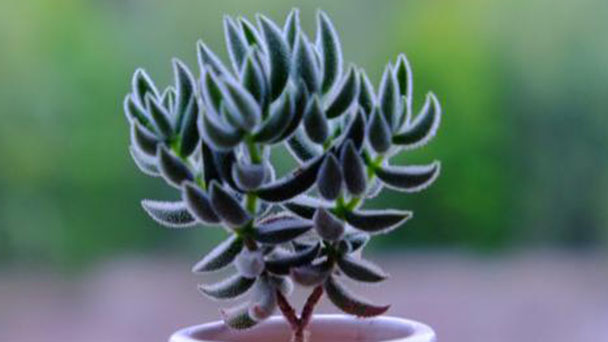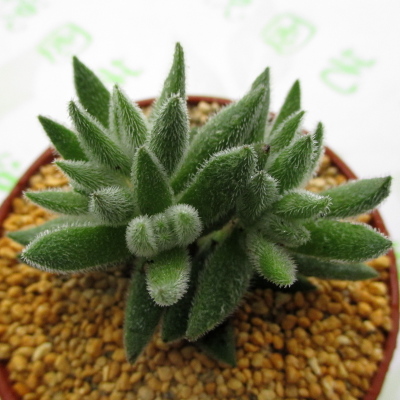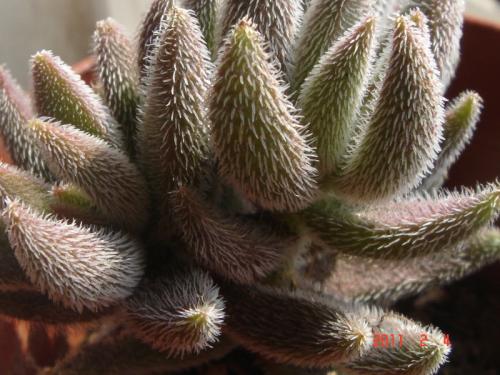Crassula mesembrianthoides: plant growing & care tips
Written by Maggie
Mar 09 2021

When we grow and care for Crassula mesembrianthoides, peat, vermiculite and perlite can be selected as the substrate for the pot, and then an appropriate amount of decayed cake fertilizer can be added to mix and stir evenly. During the growth period, the temperature should be controlled at about 15-25 ℃. When it is below 5℃ in winter, it should be moved indoors in time, and the soil in the pot should be kept dry for watering to promote the normal growth of plants. Now let's see how to grow and care for Crassula mesembrianthoides.
1. Matrix care for growing Crassula mesembrianthoides
The roots of Crassula mesembrianthoides have high requirements on soil and are suitable for growing in sandy soil with strong porosity and good water retention ability. When we grow and care for Crassula mesembrianthoides, a mixture of peat, vermiculite and perlite can be used as the culture soil. Before planting, an appropriate amount of decolorized cake fertilizer water is applied to the bottom of the pot as a long-term base fertilizer to promote root growth.
2. Light care for growing Crassula mesembrianthoides
Crassula mesembrianthoides prefers to grow in a warm environment with long sunshine, which gives its leaves a green color. When we grow and care for crassula mesembrianthoides in the peak growing season, the temperature should be kept between 15 and 25 ° C, but in high summer temperatures, it should be moved to a cool and ventilated place with good air ventilation. In winter, it should be artificially heated when the temperature is below 5 ° C.
3. Watering care for growing Crassula mesembrianthoides
The roots, stems and leaves of Crassula mesembrianthoides contain a lot of water, so water should not be watered frequently during normal maintenance, otherwise excessive water will lead to waterlogging. When we grow and care for Crassula mesembrianthoides, water should be controlled during the dormant period of high temperature in summer, and it is best to keep the pot soil dry. Water can be watered once a month after autumn, and water spraying is the main method in winter.
4. Fertilizer care for growing Crassula mesembrianthoides
Regular fertilization is a basic condition for the cultivation method of Crassula mesembrianthoides, which does not have high requirements for fertilizers. However, in order to enable the plants to grow and flourish, when we grow and care for Crassula mesembrianthoides, decomposed liquid fertilizer can be applied once a month during the peak growing season, or a compound fertilizer of N, P and K can be used, and a small amount of water can be added after fertilization to dilute the concentration.

5. Growing Crassula mesembrianthoides care for diseases and pests control
Black rot
Black rot is a common disease of Crassula mesembrianthoides. When the leaves at the bottom become black and begin to spread to the stem, it is most common in summer with high temperature. When we grow and care for Crassula mesembrianthoides, it is necessary to strengthen ventilation management, remove the blackened leaves and spray carbendazim.
Water rust
When Crassula mesembrianthoides suffers from water rust, the leaves will gradually turn yellow as if they are rusting. If not treated in time, the plants will gradually wither. When we grow and care for Crassula mesembrianthoides, good ventilation management should be maintained, the temperature should be lowered, the yellowing leaves should be pruned, and the soil should be replaced for maintenance.
Powdery mildew
Crassula mesembrianthoides is also prone to suffer from powdery mildew in the process of cultivation, mainly needles and young stems. At the beginning of the disease, spots will form and at the later stage, powdery spots will appear. When we grow and care for Crassula mesembrianthoides, white wine can be diluted 1000 times with water and then sprayed on the plants every 3 to 6 days, which can effectively treat powdery mildew.
Root rot
When we grow and care for Crassula mesembrianthoides, if overwatering, then it is easy to appear root rot and root system gradually decay and thus affect for the absorption of nutrients, if not in time to process, plants may wither and die, now need to dig out the root, pruning decay, basin after using carbendazim drug poured root disinfection sterilization.
6. Flowering and fragrance care
By the end of summer, this plant produces beautiful tubular-shaped pink flowers that form in clusters on the top of the plant.

7. Crassula mesembrianthoides propagation
Stem Cuttings
To develop Crassula mesembryanthemoides from cuttings, use a sterile, sharp knife or pair of scissors. Remove a stem from the primary plant, and permit it to callous for a number of days earlier than setting on well-draining soil. Water on every occasion the soil has dried out completely.Seeds
If propagating from seed, sow in a well-draining soil in the fall. You can develop your seeds outside if you stay in a region above 9am. If you stay in a cooler area, you can start sowing indoors beneath a develop light.8. Where to grow Crassula mesembrianthoides
Crassula mesembryanthemoides is no longer bloodless hardy, so if you stay in a quarter that receives less warm than 30° F (-1.1° C), it's first-rate to grow Crassula mesembrianthoides in a container that can be delivered indoors. It does properly in full to partial sun.Plant in an vicinity of your backyard that receives 6 hours of sunlight a day. If planting indoors, area in a room that receives a lot of sunlight, such as close to a southern-facing window (if you're in the Northern Hemisphere).
Latest Updated
- Benefits of Bugleweed - 7 Science-backed Health Benefits
- Bugleweed Dangers & Side Effects - Is It Poisonous?
- How to Plant Evergreen Trees - What You Should Know
- When to Plant Evergreens - Grow Guide for Evergreen Trees
- 12 Wonderful Evergreen Shrubs for Your Garden
- 12 Popular Evergreen Plants with Pictures for Beginners
- When And How To Prune A Lilac Bush Like a Pro
- How to Grow & Care for Lilac Vine (Hardenbergia Violacea)
- Japanese Lilac Tree (Syringa Reticulata) Care & Propagation Guide
- Shumard Oak Pros and Cons - What to Know
Popular Articles
- Winter maintenance of Antirrhinum Majus
- How to Grow Terminalia Mantaly Tree
- How to Grow and Care for Crossostephium Chinense
- How to grow Antirrhinum Majus in spring
- Peristeria Elata (Dove Orchid) Profile: Info & Care Guide
- Underwatered Snake Plant (Sansevieria Trifasciata) - Signs And How To Fix
- How to Care for Brazilian Jasmine Plant (Mandevilla Sanderi)
- How to Grow & Care for Graptopetalum Purple Delight in Summer
- Rosa Chinensis (China Rose): Plant Growing & Care Tips
- How to Care for Baby Sun Rose (Aptenia Cordifolia)